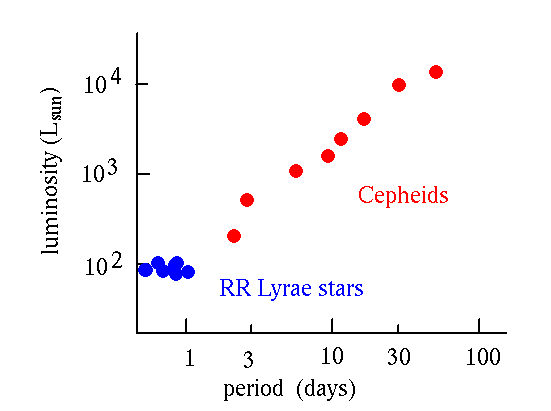Today's caption contains a functioning link to the
Shapley-Curtis debate of 1920, and I have, I must admit, struggled to read it and try to assess the arguments put forth by Shapley and Curtis. So very much less was known about our galaxy, let alone the Universe, in those days, and as I was reading the speeches by the two astronomers, I felt a renewed respect for their attempts to paint coherent and convincing pictures of the Universe we live in.
Shapley's main mistake, if you ask me, was assuming that the pulsating RR Lyrae stars in globulars clusters were bona fide Cepheid variables. But Cepheid variables are young, massive stars, five to twenty times as massive as the Sun, and therefore they are also bright, typically thousands of times brighter than the Sun. But all Milky Way globular clusters are old, and no single classic Cepheid survives in a Milky Way globular. The pulsating RR Lyrae stars so typical of most globulars are highly evolved old metal-poor stars which contain about half the mass of the Sun, and usually shine no brighter than about 50 times the Sun.
By assuming that RR Lyrae stars are as bright as classic Cepheids, Shapley placed the globulars too far above the galactic plane. Therefore he also assumed that the disk (presumably the luminous disk) of the Milky Way was much larger than it is. Shapley assumed that the diameter of the Milky Way was 300,000 light-years, but to my knowledge, extremely few spiral galaxies are that big.
Blue comet C/2016 R2 PanSTARRS in the Hyades cluster.
The spectrum of the Hyades is similar to the spectrum of a galaxy.
Photo: Rogelio Bernal Andreo.
There is a spiral galaxy that is believed to be over 400,000 light-years in diameter,
UGC 2885, but this is extremely rare. The Milky Way is believed to be about 100,000 light-years across, which is actually quite big as galaxies go.
Curtis, on the other hand, believed that the Milky Way was only about 30,000 light-years across. That is clearly wrong. But I was impressed with Curtis' reasoning regarding the "spiral nebulae". He pointed out that the distribution of these spiral nebulae is different than anything else in the sky. Everything else is found in greatest numbers where the stellar density is the highest, but the spiral nebula are found in greatest numbers where the stars are fewest. He pointed out that some spiral nebulae seen edgewise seem to have a dark band running all along the length of them, and he suggested that the Milky Way might have a similar opaque band. That would explain why we see no spiral nebulae in the luminous band of the Milky Way, because there may be a opaqueness there that blots out the light of objects far beyond our galaxy.
Curtis pointed out that the spiral nebulae have the same kind of spectrum as star clusters, strongly suggesting that they are made up of stars. He pointed out that some spiral nebulae are large in the sky, but others are very small. If we assume that they are of moderately similar intrinsic size, and if we assume that the nearest ones (such as Andromeda) are about 10,000 light-years away, then the smallest of the spiral nebulae must be far outside the presumed boundaries of the Milky Way, thus proving that there is indeed something outside of our own galaxy.
Curtis also talked about the novas that appear both in our own galaxy and in Andromeda. Novas, unlike supernovas, don't destroy the star that causes them, and they are just explosions on the surface on the stars (make that white dwarfs) where they happen. Therefore they are much fainter than supernovas. Novas are much more common than supernovas, and several had been seen both in the Milky Way and in Andromeda by the time of the Great Debate.
If we assume that the novas in Andromeda are similar to the novas in the Milky Way, Curtis argued, then we must assume that Andromeda is about 500,000 light-years distant, which makes it farther away than Shapley's 300,000 light-year diameter of the Milky Way. The figure 500,000 light-years was wrong, because the distance to Andromeda is is now thought to be about 2.5 million light-years, but Curtis' reasoning was impressive.
Ann
 Andromeda Island Universe
Andromeda Island Universe



